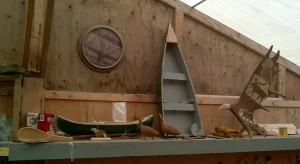A different post: This is an article I prepared after Andy’s field trip with his students. I tagged along as photographer, and wrote a trip report. It ended up with PR people at the Montreal Office and it’s being prepared it for publication. I removed last names, and did not include pictures of the elders, as I am in the process of obtaining permissions.
Any proofreading errors? Please tell me!
Traditional Cree Fishing & Chisheinuu Chiskutamaachewin Project.

Entry to Murray’s Lodge
On February 7, 2013, students of the cabinetmaking program offered by Sabtuan Adult Education Services took a morning off their woodworking projects to visit the Traditional Cree Fishing & Chisheinuu Chiskutamaachewin Project, otherwise known as Murray’s Lodge, with their teacher, Andy Anderson.
The Project comprises a series of teaching lodges arranged in a semi-circle on the bank of Lake Mistassini, just after the fork on Rte. 167, which leads to the town of Mistissini. It is a place to regain the Cree way of life through cultural knowledge and skills as passed down from elders of the community to their youth.
“The primary purpose of the trip,” Anderson explained, “is for my students to gain an understanding and appreciation of traditional methods of wood carving, tool making and other crafts.”
The secondary purpose: A hearty home-cooked lunch would be served in the dining lodge.
While some lodges are solid wood structures with wood flooring, others have wood siding that reaches only to about waist level. A tent stretches from the siding to form a roof, often with skylights. Each structure has at least one wood stove, keeping the inside toasty and cheerfully warm.

Some of the creations in the carving lodge
The class first visited the carving lodge. Inside, Henry was shaping snowshoes. He showed how the wood needed to be steamed to render it more pliable. He indicated towards a large contraption, which generates steam for this purpose. After being shaped, the snowshoe would stay in a mold for several days.
Standing next to Henry, Alfred carved shovels. He demonstrated various sizes, which could be used from stirring stew to scooping ice out of fishing holes.
Ben pulled items out of a box to show the class: a caribou hide rattle, a toy toboggan, and trimmings for drum making. He reached for a miniature axe.
“This is for the walking out ceremony,” Ben said, “When a young child reaches around the age of two, after they start walking, they are given this. It is a very important occasion.”
Ben then held up hand-crafted skewers. “This is for cooking beaver.” He demonstrated how beaver would be roasted over a fire, and twirled for uniform cooking.
“I love beaver,” he added. “We are having it here next week, but I like it cooked inside out so the fat runs off.”
Harry Meskino further demonstrated traditional carving and shaping techniques.
“Birch is usually the wood of choice,” he said. “It is easier to bend.”
At the medicine lodge, Bella and Pat explained traditional medicine made from the bark of gray alder, birch, and tamarack and also from leaves such as labrador tea. The students had questions for various ailments for themselves and family members. Blacksmith said that this knowledge of medicine could only be passed on to members of the Cree community.
Labrador tea was offered to the visitors. It was smooth and woodsy, with a slightly bitter aftertaste.

Woman’s Sewing Lodge
An embroidered hide marks the entrance to the sewing lodge. By lifting the hide, entry is gained into a ‘cold room.’ This room acts as a buffer from the frigid air, before entering the main lodge. The flooring here is remarkably soft and buoyant, as carpets are stretched over a thick layer of evergreen boughs.
At a long table, elders and young women were working on various sewing projects.
Elizabeth showed her star-shaped brilliant blue bead work, stitched on a piece of hide. She explained the significance of colours and how they were indicators of family groupings.
Ella pulled out a basket of items in various stages of completion, including an intricate beaded, embroidered bag used to carry bullets, a large pouch for transporting bedding and many baby items. She demonstrated how a baby would be wrapped up and protected in layers of blankets. In past times, moss was used as diapers. “It is not any moss,” she said, “but a brown moss. It is dried all summer and sticks are shifted out to make sure it is soft.”
At the fishing lodge, Emily was weaving a fish net, working a hand-carved wooden shuttle between the nylon threads. It would take about a month to complete.
“These nets are for normal fish,” she said and gestured towards Emma. “She is weaving a stronger net for sturgeon.”

Fresh game, fry bread, bannock and stew
At noon, Anderson and his students headed towards the dining lodge.
Winnie, head chef, was asked for permission to take photographs.
“Oh, yes,” she joked, her face crinkling. “Only if they are all of me!”
Winnie explained that food is prepared at the lodge and fresh game is donated by local hunters.
Today, Winnie is helped by Sophie, Lizzie, Mary Jane, Jane, and Carla.
The central table was heaped with food. First in line was a steaming pot of soup/stew made with bacon and an unspecified meat, wafting a gentle cinnamon-like scent. Laid out next were a pan of mashed potatoes and carrots, a sheet of shepherd’s pie, well-done moose steaks, fry bread, bannock plain and with raisins, and blueberry preserves.
Before lining up for lunch, Johnny led in a prayer of thanks in Cree.
 After lunch, the students observed traditional hide preparation. A pale beige moose hide was stretched taut across a wooden rack. Fat and meat were shaved off, like curls of frozen butter, with a long wood-handled metal tool. When Alice was asked if she ever accidentally made holes in this painstaking process, she replied, “Yes, sometimes when I get tired.”
After lunch, the students observed traditional hide preparation. A pale beige moose hide was stretched taut across a wooden rack. Fat and meat were shaved off, like curls of frozen butter, with a long wood-handled metal tool. When Alice was asked if she ever accidentally made holes in this painstaking process, she replied, “Yes, sometimes when I get tired.”
After an enlightening morning, students returned to the whirring and buzzing of their woodworking shop. Maybe, as they are operating power drills, planers, lathes and routers that have made working with wood less time consuming, they might stop for a moment and ponder the dedication and skills of their ancestors.








